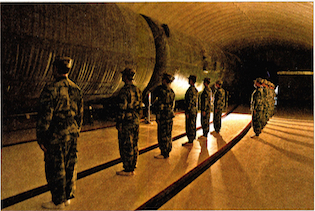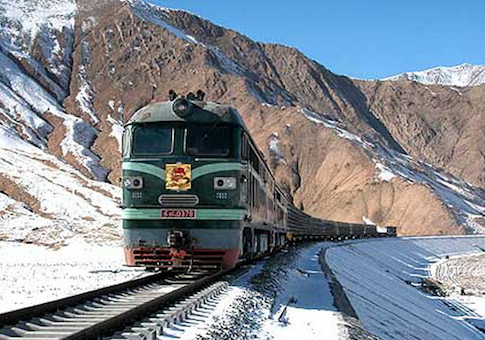China’s Defense Ministry confirmed on Thursday that its military recently conducted a test of a new rail-mobile ICBM capable of hitting any part of the United States with nuclear warheads.
Defense Ministry spokesman Col. Yang Yujun also did not dispute U.S. reports that its nuclear missile submarines began conducting sea patrols for the first time, giving China a potent new submarine-based strategic nuclear strike capability.
Yang also disclosed new details on China’s plans to build a second aircraft carrier, a vessel which is currently under construction at a northeastern coastal shipyard at Dalian.
On the test of a new multi-warhead DF-41 intercontinental ballistic missile (ICBM), first reported by the Washington Free Beacon on Dec. 21, Yang was asked about U.S. intelligence agencies detecting the rail mobile ejection tube missile test and whether he could confirm it.
"Scientific tests within the Chinese territory are conducted according to plan," he said, without elaborating.
The DF-41 missile is China’s newest and longest-range nuclear strike weapon, and has a range of up to 7,456 miles. The missile was flight tested on Dec. 4 in a separate test from the rail tube ejection test, which took place Dec. 5. Both tests were carried out at a missile launch complex in central China.
Defense Ministry press conferences are tightly controlled propaganda operations, with questions from Chinese reporters prepared in advance and answers carefully scripted and approved by China’s military propaganda department.
The comments by Yang on strategic weapons systems came during a year-end press conference and indicate China has shifted slightly from its past policy of refusing to disclose any details of its strategic nuclear forces over concerns that releasing information will undermine the forces’ deterrent value.
On the new aircraft carrier, Yang said the new carrier would be built indigenously. China’s first aircraft carrier, the Liaoning, was refurbished from an unfinished Soviet-era carrier purchased from Russia.
"Taking various factors into consideration, relevant authority started the research and development of China’s second aircraft carrier, which is currently under independent design and construction," he said.
Yang sidestepped a question about whether the Liaoning would conduct operations in open ocean waters.
A U.S. warship that was monitoring the Liaoning in the South China Sea touched off an international incident in December 2013 that has led to heightened U.S.-China tensions in the region.
The guided-missile cruiser USS Cowpens was confronted by a PLA Navy amphibious assault ship that stopped in front of the Cowpens, nearly causing a collision.
Yang said the new carrier will be designed similarly to the Liaoning with a ski-jump takeoff ramp, and will carry J-15 fighters.
"It has a conventional power plant with a displacement of 50,000 tons," he said, adding that the new warship will mark an improvement over the Liaoning.
On the submarine patrols, Yang was asked to comment and said: "I think the report by foreign media is purely media hype."
The Washington Times reported Dec. 9 that the U.S. Strategic Command had confirmed that Beijing has begun patrols of Jin-class nuclear missile submarines equipped with JL-2 submarine-launched ballistic missiles.
"Given China’s known capabilities and their efforts to develop a sea-based deterrent, in absence of indicators to the contrary, it is prudent to assume that patrols are occurring," said Navy Capt. Pamela S. Kunze, a Strategic Command spokeswoman, of the patrols.
The Pentagon has said the JL-2 gives China a significant nuclear attack capability.
In November 2013, a Communist Party-affiliated newspaper, Global Times, published a report showing the effect of JL-2 nuclear strikes on the western United States, estimating that attacks on Los Angeles and Seattle would kill up to 12 million Americans.
Confirmation that the DF-41 will be rail-based in addition to being deployed on road-mobile transporter-erector launchers also followed an unusually detailed state-run television report last week discussing the rail system, which will employ a dedicated track and tunnel system stretching across several thousand miles in central China.
Chinese military analysts provided explicit details about both the DF-41 and nuclear missile submarine patrols during a state-run CCTV television report Dec. 23.
Rear Adm. Yin Zhuo, a political commissar, told CCTV that he would wait for "information from our Ministry of Defense" before commenting on the rail-based DF-41. But Yin said China’s nuclear prowess is increasing and will not stop.
Yin then repeated official the Chinese position that nuclear weapons should not be viewed as threatening because of Beijing’s so-called "no-first-use" policy, a commitment the Pentagon has questioned. The threat of China’s nuclear forces buildup should not be played up because, "if you do not strike at me first, I am of no threat to you," he told the television network.
A second military expert, Chinese Army Sr. Col. Li Li, a professor at the People’s Liberation Army National Defense University, commented on whether rail-launched ICBMs are less mobile than their road-mobile counterparts. Li said strategic nuclear missiles are large in size and not all roads and tunnels can handle them.
According to Li, rail-based ICBMs are more difficult to detect for spy satellites than road-mobile ICBMs because they can be disguised as passenger rail cars, and the missiles cannot be spotted until they are launched.
Li said the rail-mobile missile cars will be the same color as all of China’s passenger rail cars, which in the future will be the same color, instead of the current variety of red, green, white, and blue cars.
Standardized colors will make rail-mobile ICBMs "stealthier," he said, noting that the missile trains will travel at much higher speeds than road-mobile missiles, a further complication for satellite tracking.
Yin was asked if rail-based ICBMs will be capable of striking the U.S. East Coast and said China’s ICBMs are not targeted at any country.
However, Yin said Chinese missiles must match the U.S. military program of striking any location in the world, a reference to the Pentagon’s program known as conventional Prompt Global Strike.
Prompt Global Strike includes ground, air, and space weapons capable of hitting any target on earth in 60 minutes or less.
Li added that China’s land-based ICBMs supplement nuclear counterstrike capabilities but are vulnerable to being preemptively wiped out, as opposed to submarine-based nuclear missiles that provided a guaranteed counterstrike power.
The two military officials were then asked about U.S. and Japanese reports that China has begun the first nuclear missile submarine patrols.
Yin said the new Type 094 ballistic missile submarines are similar to other nuclear powers’ systems and are absolutely necessary.
According to Yin, in a nuclear conflict, the survival rates for missile launch pads are expected to be 5 percent to 6.5 percent; are 10 percent to 15 percent for road-mobile systems; and are around 20 percent for rail-mobile missiles. Comparatively, missile submarine survival rates are more than 85 percent, he said.
Li, echoing the Defense Ministry spokesman, downplayed U.S. and Japanese reports of the missile submarine patrols as a "packaged media campaign" reflecting both countries’ fears of China’s growing maritime power.
Li said Chinese nuclear missile submarine development would aim to increase missile range, improve precision guidance, and raise the number of deliverable warheads. He added that China plans to develop its nuclear forces on land, sea, and air to match those of other world powers.
U.S. intelligence agencies until recently assessed that China’s nuclear warhead stockpile was limited to around 250 to 300 warheads.
However, the recent deployment of multi-warhead missiles, including the DF-41 and DF-5, is expected to increase the warhead stockpile significantly.

In a second unusual disclosure, the official newspaper of the Second Artillery Force, as China’s nuclear and missile forces are known, in July published a photograph of several large diameter missiles on a underground train. The missiles appeared to be in storage and were not rail mobile systems.
China’s DF-41 rail mobile missile is based on the now-dismantled Soviet SS-24 rail-mobile ICBM. Russia’s government announced recently it is planning to develop a new rail-mobile ICBM, which Moscow officials have said is needed to counter U.S. Prompt Global Strike weapons.
